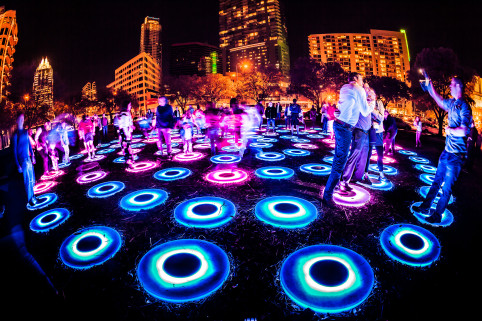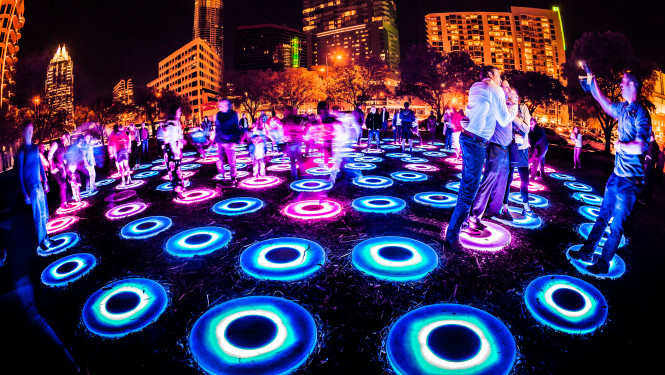This is our first post in a series of artist interviews. In these interviews, we asked artists to share their words of wisdom, lessons learned, and encouragement to new artists. Our community’s artists are a wealth of knowledge–this is just one way we here at Voices of Burning Man can support the advancement of innovative and collaborative art.
“Tripping the light fantastic” takes on a literal meaning with Jen Lewin’s fabulously interactive light sculptures The Pool and The Super Pool. The Boulder, Colorado-based light sculptor and her team have carved out an enviable international reputation with the giant concentric circles of circular pads emitting ever-changing colors of shifting and fading light. The Pool debuted at Burning Man in 2008, and received a Global Art Grant, to support the work’s exhibition in other cities, later that year.

Delighted people worldwide step, hop, and skip into a seemingly simply but technologically complex environment where they can individually or collectively create dazzling, luminous patterns. Light is enlisted and directed through chance choreography. One form of energy—human movement—is transformed into another. The pooling of spontaneous collaborative effort create infinite variations on a theme. Lewin’s work has been wildly successful beyond the site-specific conditions and demographics of the playa at Burning Man. She took a break from her insanely busy schedule to answer a few questions on the challenges of creating and sustaining interactive art for all forms of community, the promotional challenges for her creation, and to offer some advice for artists embarking on this path.
Peter: What was your hope for The Pool when you designed it?
Jen: The Pool started with a passionate vision for what I wanted the sculpture to be. It took years to really actualize this and physically create what I was able to so easily imagine. I wanted to create a giant, fully interactive and beautiful environment of light that could allow participants to both play actively with the sculpture, but also with each other. I wanted to create a piece that could go anywhere in the world, and could connect, create, and activate community through art.
There were lots of hiccups, and LOTS of learning experiences. The first time we built and installed The Pool in 2008 it was completely destroyed, and my team and I were devastated. But we jumped back, and fully rebuilt the sculpture in 2009. Since then I have rebuilt the piece yearly. Some of these rebuilds have been entirely from scratch with all new technology, and some have been adaptations. We have collaborated both successfully and unsuccessfully with outside teams and learned a lot!!!
Over time we have honed the piece, and really mastered its production. The reality is that it is VERY hard to make a piece that is this interactive. The Super Pool for example has almost as many controllable LEDS as the Bay Lights Project. However, we allow users to jump, bang, and stomp on our controllers. We take the piece into the snow, ice, heat, and travel with it worldwide. This results in a pretty amazing challenge.
Peter: Where did you see it going beyond Burning Man?
Jen: I always saw the piece as going beyond Burning Man. I love Burning Man, but my objective is to create community through art, and Burning Man, while amazing, is only one type of community on earth. I feel very strongly that the sculpture needed to speak to other groups, cultures, and needed to work in all types of environments.
I believe very strongly in the participatory nature of Burning Man art and its root philosophy, but I also feel strongly that this philosophy needs to expand into the rest of the world. As Burning Man artists this should be one of our goals.
Peter: What have been the challenges in showing your work publicly?
Jen: Raw logistics are a real thing. Negotiating contracts, negotiating budgets, dealing with crating and freighting, and issues with on-site power and installation problems—this is the hard part.
Then of course, beyond this mountain of logistics, the sculpture has to be built to survive. Part of this is assumes for failure. We know that 5% of our pucks will break per transit. We know that the onsite power will likely be faulty and crates will not arrive on time. We plan for this and have very specific structures to enable my team to expect these types of issues, and work through them. It’s a ‘cup half empty’ and ‘cup half full’ mentality. It’s all going to fail, but we can work with this.
As an artist, you also need to evolve to be a great business operator. You need to manage a team, manage a budget, and manage your sculpture. It is through doing this that you can then manage a great and successful public exhibition. I know we often like to imagine the artist as a solo, crazed, creative, and unique individual without any business acumen, but I think this is a romantic idealized myth that is not really helpful. In truth, most of the prolific artists throughout human history have been business savvy. To be honest, I am not the best manager, however, I have committed to working on this, and it has helped me immensely.
Peter: Your work has now been seen at over 30 major installations worldwide. How did you connect with these opportunities?
Jen: Getting your work out there is a numbers game. A lot of artists don’t want to admit this.
When I got started, for every 10 submissions (comprehensive full submissions that a lot of time to do) I got 1-2 bites back. Of these bites, about 50% became a real show/project.
Over time, and as my reputation increased, my success rate for submissions increased. HOWEVER, even today, only about 1/2 of our submissions become a reality. This means that for those 30 shows you are referring to, we had at least 60 submissions.
Right now we apply and submit for a project weekly. This equates to just work — unstoppable work. You can’t get discouraged by rejections. You just need to keep working, keep submitting, and keep trying.


As a woman, and as an artist, I really appreciated what was said. When I wanted to take some business courses in college everyone thought I was crazy, but, already they have paid off. I do believe, however, that there is still room for the “crazy, loner” artists, although unfortunately they usually don’t get recognized until they’re gone. Beautiful work, and sound advice, thanks!
Report comment
Comments are closed.